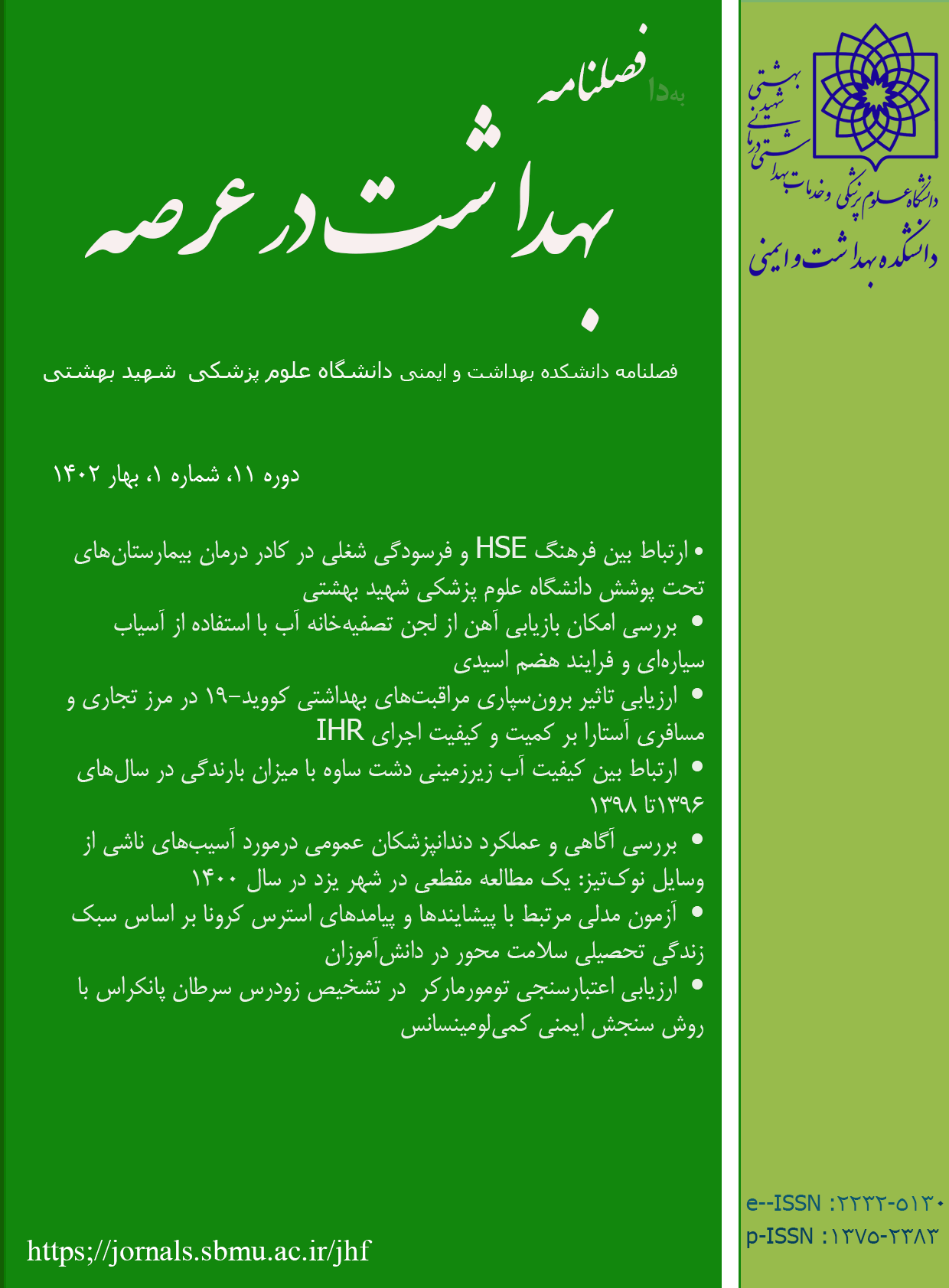تبيين ادراک زنان وکارشناسان واحد بهداشت خانواده از موانع پوشش مراقبت هاي پيش از بارداري: يک مطالعه کيفي
فصلنامه علمی پژوهشی بهداشت در عرصه,
دوره 4 شماره 3,
22 شهریور 2017
,
صفحه 18-27
https://doi.org/10.22037/jhf.v4i3.13984
چکیده
زمينه و اهداف: مراقبتهاي قبل از بارداري مجموعهاي از مداخلات در مرحله پيشگيري و درمان است که با هدف شناسايي و تعديل مخاطرات زيست- پزشکي، رفتاري و اجتماعي انجام ميشود. مطالعه حاضر با هدف تبيين ادراک زنان و کارشناسان واحد بهداشت خانواده از موانع پوشش مراقبت پيش از بارداري در مراکز بهداشتي تحت پوشش دانشگاه علوم پزشکي ايران انجام شد.
مواد و روشها: در اين مطالعه کيفي 32 نفراز مادران و کارکنان واحد بهداشت خانواده (کارشناسان مامايي و بهداشت خانواده) شاغل در مراکز و پايگاههاي بهداشتي تحت پوشش دانشگاه علوم پزشکي ايران مورد مصاحبه گروهي و فردي قرار گرفتند. نمونهگيري بصورت مبتني بر هدف انجام شد. اطلاعات از طريق مصاحبه و بحث گروهي متمرکز با سؤالات باز تا زمان اشباع دادهها جمعآوري گرديد و به شيوه تحليل محتواي قراردادي (content analysis conventional) با رويکرد گرنهايم و لاندمن (2004) تحليل گرديد. به منظور رعايت موازين اخلاقى، به مشاركت كنندگان، هدف تحقيق، محرمانه بودن دادهها وآزادى آنها براى خروج از مطالعه توضيح داده و رضايت شفاهى آنها كسب شد.
يافتهها: پس از تحليل دادهها، موانع درک شده پوشش مراقبت پيش از بارداري در قالب سه مفهوم اصلي شامل: موانع سازماني، موانع ارتباطي و موانع فردي به دست آمد.
نتيجهگيري: يافتههاي حاصل از مطالعه نشان داد که از نظر آنان، عوامل سازماني، ارتباطي و فردي متعددي بر پوشش مراقبت پيش از بارداري در مراکز بهداشتي تحت پوشش دانشگاه علوم پزشکي ايران، تاثير گذار هستند که اين عوامل ميتواند اولويت بندي شده و راهکارهاي مناسب براي ارتقاء خدمات پيش از بارداري اتخاذ شود.
- مراقبتهاي پيش ازبارداري، موانع، ادراک، سلامت مادران، سلامت زنان
ارجاع به مقاله
مراجع
Jahani Shoorab N, Ghaffari Sardasht F, Jafarnejad F, Ismaeeli H. Assessment Of Prenatal Care Process Based
on Donabedian Model in Mashhad Health Centers. Iranian Journal of Obstetrics, Gynecology and Infertility
;16(53):7-17 .(In Persian)
Soltani R,Alizadeh SH,Majidi S.Trends of maternal mortality rate in the world between the years 1990 & 2010.
Proceeding of the 13th Obstetrics & Gynecology Congress; 2012 Dec. 17-20; Tehran, Iran (In Persian).
Ansari Niaki M, Izadi Sabet F. The quality of prenatal care performance on the basis of existing care standards in health centers. koomesh Journal 2004; 5(1):83-88 (In Persian).
Department of Family Health and Population. Maternal mortality surveillance. Isfahan: Health Center 2005 (In
Persian).
Atrash HK, Johnson K, Adams MM, Cordero JF, Howse J. Preconception care for improving perinatal outcomes:
the time to act. Maternal and Child Health Journal 2006; 10(1):3-11.
Hajizadeh SH, Farshid Moghadam M. Women need to take care of before pregnancy. Behvarz 2008; 19(3):46-47 (In Persian).
Shahidi SH, Aghdak P, Izadi M. Effect of preconception care protocol on women`s awareness. Journal of
Education in Medical Science 2008; 10(5):525-32 (In Persian).
Emami AN, Jalil P, Radpooyan L, Azmikhah A, Motlagh MA, et al. The Promotion & Improvement of the System
of Maternal Care & Maternal Mortanility Prevention. Tehran: Tandis Publication; 2006 (In Persian).
Wallace M, Hurwitz B. Preconception Care: who needs it, Who Wants it, and how should it be Provided? The
British Journal of General Practice 1998; 48(427):963-66.
Cunningham GL, Bloom J, Gilstrp L,Wenstrom K. Williams Obstetrics. New York: McGraw Hill; 2014.
Atrash HK, Johnson K, Adams MM, Cordero JF, Howse J. Preconception care for improving perinatal outcomes:
the time to act. Maternal and Child Health Journal 2006; 10(1):3-11.
Brundage SC. Preconception health care. American Family Physician 2002; 65(12):2507-14.
Aaron E, Criniti S. Preconception health care for HIV-infected women. Topics in HIV medicine: a publication
of the International AIDS Society, USA 2006; 15(4):137-41.
Association AD. Preconception care of women with diabetes. Diabetes Care 2004; 27(suppl 1):s76-s78.
Ministry of Health and Medical Education. Health policy council of the Islamic Republic of Iran in the Fifth
Program of Economic, Social and Cultural Development, Millennium Development Goals. Tehran: Ministry of
Health and Medical Education; 2009 (In Persian).
Abedi HA. Applying phenomenological method of research in clinical sciences. Rahbord 2010; 19(54):207-224 (In Persian).
Graneheim UH, Lundman B. Qualitative content analysis in nursing research: concepts, procedures and measures to achieve trustworthiness. Nurse Education Today 2004; 24(2):105-12.
Hsieh HF, Shannon SE. Three approaches to qualitative content analysis. Qualitative Health Research 2005; 15(9):1277-88.
Tabatabaee A, Hasani P, Mortazavi H, Tabatabaeichehr M. Strategies to enhance rigour in qualitative research.
Journal of North Khorasan University of Medical Sciences 2013; 5(3):663-70 (In Persian).
Seyed Aghamiri ZB, Vijeh M, Sedaghat M, Sabery Namin M. Why do pregnant women refuse to attend staterun prenatal clinics? Payesh 2007; 6(2):129-33 (In Persian).
Azemikhah A. New Managemnet System for Reproductive Health. Tehran: Ministry of Health and Medical Education; 2003 (In Persian).
Kharghani R, Mohajer Rahbari M, Olfati F, Keramat A. Reasons of unmet needs of family planning from the
perspective of health personnel. Journal of Qualitative Research in Health Sciences 2013; 2(3):277-86 (In Persian).
Simbar M, Nahidi F, Akbarzadeh A. Assessment of quality of prenatal care in health centers of Shahid Beheshti University of Medical Sciences. Payesh 2013; 11(4):529-44 (In Persian).
Khayatan M, Nasiripour AA, Amini M, Mohamad Nejad SM. The effective factors on recievers’access to health
care services inurban health care centers. Journal of School of Allied Medical Sciences 2010; 4(3,4):18-27 (In
Persian).
Ghanbari Sh, Majlessi F, Ghaffari M, Mahmoodi Majdabadi M. Evaluation of health literacy of pregnant women in urban health centers of Shahid Beheshti Medical University. Daneshvar Medicine 2011; 19(97):1-12 (In Persian).
- چکیده مشاهده شده: 304 بار
- PDF دانلود شده: 251 بار
